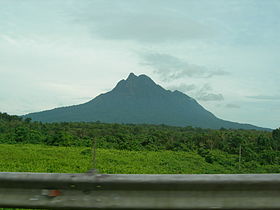- Mount Santubong
-
Mount Santubong 
Mt. Santubong from Santubong BridgeElevation 810.2 m (2,658 ft) Prominence 810 m (2,657 ft) Location Location Sarawak, Borneo Coordinates 01°44′N 110°20′E / 1.733°N 110.333°E Climbing First ascent Unknown Easiest route Hike Mount Santubong (Malay: Gunung Santubong) is a mountain in the Malaysian state of Sarawak. It is located about 35 km north of the state capital Kuching.
On a clear day, it can be seen from Kuching. The mountain and its surrounding area is a popular tourist attraction.
Contents
Etymology
According to the Encyclopaedia of Iban Studies the original inhabitants of Santubong were the Iban. Si-antu-ubong means 'spirit boat' in the Iban language. Antu is hantu in Malay which means spirit or ghost. Santubong are boat like coffins made from a single hollow log designed to represent the vesell in which a dead person will travel from this world to afterlife. Following another theory, the name Santubong is derived from "san choo bong" in the Hakka Chinese dialect, meaning "wild pig king" or "king of wild pig".[citation needed]
History
Excavations of the surrounding area uncovered Hindu and Buddhist relics from the 9th Century CE. Song and Tang dynasty ceramics are also found, indicating that the area around the mountain was a trading port from the 11th to 13th century.
Legend
A legend often associated with the mountain is of two beautiful princesses, Santubong and Sejinjang. Santubong was an expert weaver while Sejinjang was an excellent rice tresher. One day, they had a quarrel and exchanged blows. Sejinjang swung her tresher which hit Santubong's cheek. Santubong threw her weaver at Sejinjang, hitting her in the head. Putting an end to the quarrel, the King of Heaven cursed both of them into mountains. Santubong turned into Mount Santubong while Sejinjang was turned into Mount Sejinjang. It is said that Mount Santubong resembles a woman lying on her back.
Importance to Biological Science
In 1855 a British naturalist, Alfred Russel Wallace[1] who was collecting animals in Santubong, wrote a paper called "Sarawak Law" [2] which can be considered as a precursor to the biological theory of evolution. A year later, Wallace left Sarawak and wrote another article on evolution based on his years of observation in the Far East, that was sent to Charles Darwin and was simultaneously published by the Royal Society. Similar to Galapagos, Mount Santubong should be considered as a scientific world heritage in biological science and should be preserved for the future genarations. Unfortunately, the proposal to established the area as a national park never materialise and human settlements as well as touristic development (hotels, golf course and condominium) are claiming most of the low lying areas. It is suggested the world community to set up a fund to buy back the land and save Mount Santubong that is very important in the development of concepts and theories in biological sciences.
The Ascent
It takes between 3 and 4 hours to reach the summit and slightly less to descend again. Climbers need to take plenty to drink and some food to keep them going. A BBQ has been built at the top but begin your descent by 3pm to get back in the day light and avoid stepping on snakes that cross the path sometimes. A lucky climber may be rewarded with the chance of a rare Hornbill with a cream/yellow beak. These Hornbills are black and white.
Villagers say the well at the top never dries up, however this pond is often sadly full of rubbish today and should not be relied upon as a source for thirsty climbers. In fact Lord Medway reported it to be dry on his overnight expedition to the top in the 60's before the ropes and ladders were installed. Cub scouts and guides once camped at the top too on their expeditions.
External links
- Satellite image from Google Earth
- Sarawak Tourism page on the mountain
- A song about the two princesses, with translations
References
- National Parks of Sarawak, by Hans P. Hazebroek, Abang Kashim bin Abang Morshidi. ISBN 983-812-032-4.
- The Encyclopedia of Malaysia, ISBN 981-3018-47-X.
- On the Law Which Has Regulated the Introduction of New Species.
- AR Wallace travelog to Borneo and the Malay World.
Categories:- Mountains of Sarawak
Wikimedia Foundation. 2010.



